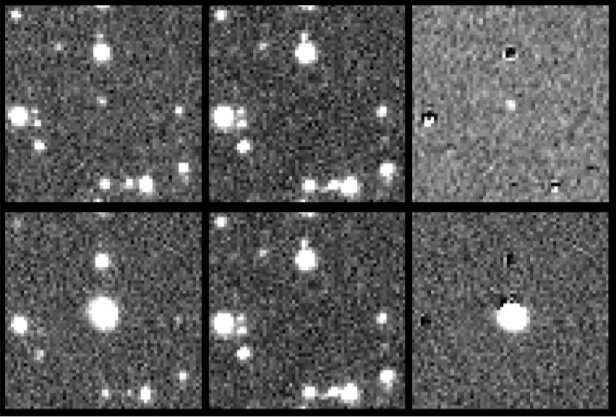The top 3 panels show the Zwicky Transient Facility (ZTF) first detection of the nova V2891 Cygni on ZTF images. The bottom panels show the nova close to maximum light. Credit: Kumar et al., 2021.
An international team of astronomers has performed multi-epoch optical and near-infrared observations of a slow nova known as V2891 Cygni. Results of the study, published December 26 on the arXiv pre-print repository, deliver more insights into the nature and properties of this peculiar source.
A nova is a star experiencing a sudden increase in brightness and slowly returning to its original state, a process that could last many months. Such an outburst is the result of the accretion process in a close binary system containing a white dwarf and its companion.
V2891 Cygni (other designations AT 2019qwf, PGIR 19brv and ZTF19abyukuy) is a highly-reddened nova of spectral class Fe II that was discovered on September 17, 2019, during regular survey operations of the Palomar Gattini-IR telescope. Analysis of its light found that it is indeed a slow nova whose brightness fluctuated around maximum for a considerable time, what was followed by a slow decline.
A group of astronomers led by Vipin Kumar of the Physical Research Laboratory (PRL) in Ahmedabad, India, studied V2891 Cygni and its evolution. For this purpose, they observed this nova using several ground-based facilities, mainly the 1.2m Mt. Abu Telescope in India.
"In this study, we have explored the optical and NIR spectroscopic evolution of the nova V2891 Cygni, one of the slowest novae recorded in recent times. Our optical and NIR [near-infrared] spectroscopy campaign lasted around 13 months (November 2019 Nov–December 2020) and utilized several facilities worldwide," the researchers wrote in the paper.
The study revealed that the light curve of V2891 Cygni is of the so-called "jitter" class, as it showcases a couple of episodes of re-brightening, most likely due to periodic mass ejection. The data show an initial rapid brightening from quiescence and the presence of a 35-day-long pre-maximum halt.
By analyzing the evolution of V2891 Cygni, the astronomers identified a dust formation event approximately 273 days after the outburst, along with the production of coronal line emission in the near-infrared band. The researchers assume that the coronal emission is most likely caused by shock heating rather than photoionisation, and that the episode of dust formation is shock-induced. Such behavior is rarely seen in the evolution of novae.
"Thus, the present data set and our associated analysis would be of interest to the community to explore the physics of the nova phenomenon," the authors of the paper noted.
The study found that the distance to V2891 Cygni is about 17,930 light years, and its reddening is at a level of 2.21. The results suggest that the nova has a gas mass of approximately 0.84 millionth of the mass of the sun, while the temperature of the gas is estimated to be between 480,000 and 910,000 K. The data also point out to an overabundance of aluminum and silicon.
More information: Vipin Kumar et al, Optical and near-infrared spectroscopy of Nova V2891 Cygni: evidence for shock-induced dust formation. arXiv:2112.13425v1 [astro-ph.SR], arxiv.org/abs/2112.13425
© 2022 Science X Network
























